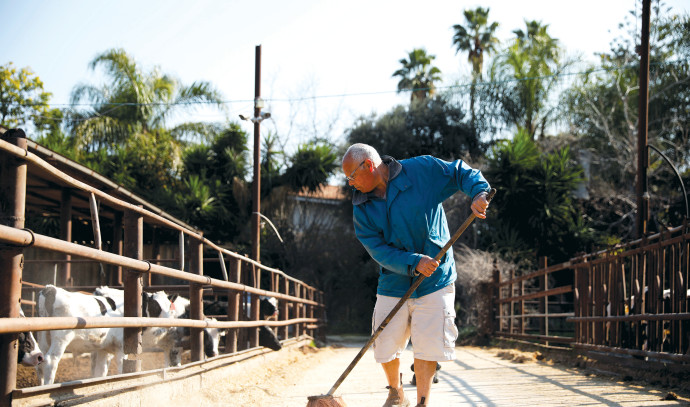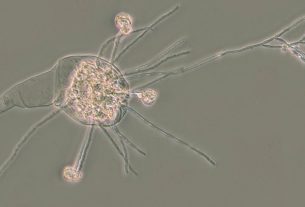|
Getting your Trinity Audio player ready...
|
In a world with growing hunger, a third of the world’s food is wasted. Fully 1.3 billion tons of food a year is discarded. Imagine how many people could be fed if just half that wastage were saved and consumed.
But there is a more insidious shanda (scandalous shame): cows and cattle.
Beef cattle are wasteful. In our hungry world, they consume seven calories of food for every one calorie of meat. That’s 85% wastage. If we ate the corn American ranchers feed their cattle, we’d be far ahead. We can no longer afford to eat meat.
What about dairy milk? That too is a problem. There are 270 million dairy cows in the world. Cows burp methane. And methane is far worse than carbon dioxide for the climate crisis.
Studies show that one cow produces up to 264 pounds (120 kgs.) of methane gas per year. Cows belch methane because it is generated when they digest coarse grasses and hay.
There are some 1.5 billion cattle in the world, raised for meat production. They emit up to 400 billion pounds of methane into the atmosphere yearly. And methane is more than 28 times more harmful than carbon dioxide, in wrapping the Earth in a blanket and causing the climate crisis.
Some 77% of agricultural land is used for animals, even though this sector produces only 17% of the world’s food supply. A third of agricultural water goes to animals, when it could be used for thirsty humans.
Livestock production – primarily cows – produces 14.5 % of global greenhouse gas emissions.
We can no longer afford the luxury of drinking cows’ milk and eating beef. Record heat in July in Israel and abroad has brought this fact home.
But wait. There is a solution.
Technology to the rescue! We now have non-animal meat and real milk without cows. Israeli start-ups are among the pioneers. There are milk and meat products made with proteins and vegetable products that taste incredibly like the foods dairy cows and beef cattle produce.
Is it fleishig (meat)? Or milchig (dairy)? Well, yes, it is meat, and it is milk. But no, they are neither milchig nor fleishig, based on some leading rabbinical decisions.
I think these breakthroughs are the future in food production. Here, below, is how it is done.
How do you produce real milk without dairy cows?
An Israeli start-up, Remilk, founded by Aviv Wolf, announced last year that it will open a huge facility for producing cow-free milk in Denmark. No, it’s not soy, oat, almond or coconut milk. It’s real milk.
Remilk is only four years old. It found a way to make milk proteins using a yeast fermentation process. The resulting milk proteins are chemically identical to those produced by dairy cows – but are “free of lactose, cholesterol, growth hormones and antibiotics” that often occur in dairy cows, Wolf says.
Wolf and scientist partner Ori Cohavi analyzed the chemical composition of milk. They found that the key ingredient in milk is the proteins. So Remilk takes the genes that encode milk production and inserts them into a single-cell microbe. They manipulate the microbe genetically to express the protein efficiently and in a scalable manner. The product is then dried into a powder. Presto. Non-dairy milk!
“Relying on animals to make our food is no longer sustainable,” Wolf told Times of Israel reporter Ricky Ben David. Remilk’s gain in efficiency is astonishing. It is 100 times more land-efficient than existing dairy systems; 25 times more feedstock-efficient; 20 times more time-efficient; and 10 times more water-efficient.
The Danish Remilk factor’s proteins, for use in cheese, yogurt, and ice cream, will match volumes produced by the equivalent of 50,000 cows each year!
According to Fortune magazine, the dairy alternatives market, now worth $23 billion, will more than double by 2028. And this does not include plant substitutes like soy, almond, oat and coconut milk.
People are extraordinarily conservative when it comes to food. Will they buy Remilk milk and milk products? A US poll commissioned by Remilk among non-vegan US adults found this: People are unwilling to give up real-dairy cheese (57%), pizza (53%), and ice cream (50%) unless the substitute is truly similar or identical.
Remilk is holding public tastings of yogurt and ice cream made with its non-animal dairy products. Let’s hope people love them.
How do you produce meat that tastes like meat but is not made from beef cattle?
Technion professor Shulamit Levenberg and her lab generate an unending stream of game-changing research. Her discovery of how to vascularize (create a blood supply for) stem cells led to breakthroughs in repairing ailing hearts and, in mice, in restoring broken spinal cords.
She co-founded Aleph Farms, together with Didier Toubia and Dr. Neta Lavon, in 2020, which has created the world’s first cultivated steaks, grown in cultures from the cells of a cow. “Mind-blowing flavor, world-changing potential,” say the founders.
Here is how it works. Aleph Farms needed a source of premium cow cells. And they discovered Lucy, a premium, beautiful Black Angus cow from a breeding farm in California. All they needed was a one-time collection of Lucy’s fertilized eggs (ova). They allow a fertilized egg to develop for a short period of time, and then derive cells from it. These cells can mature into meat.
The “starter cells” are put into a growth tank called a cultivator. The cultivators are a temperature-controlled, clean, closed environment where cells can thrive. The cell food contains everything that the cells need to live and grow – oxygen, water, nutrients and growth factors. And the starter cells multiply quickly.
“P’ru ur’vu!” (Be fruitful and multiply!), the Bible commands. The first mitzvah. The cells comply.
Aleph Farms puts the young cells into separate cultivators, to grow into different cell types, for muscle and for collagen. They use a plant protein matrix made of soy and wheat that enables the cells to form the shape and texture of an Aleph steak. Yum.
In about four weeks, the steaks are ready for harvesting and packaging.
In a landmark moment, Aleph Farms made the first cultivated meat in Europe that gained approval by Swiss regulators.
Innovating culture-based meat, while eco-friendly, efficient, tasty and profitable, is not easy. Expectedly, there is fierce, predictable pushback from farmers, ranchers, and meat producers. In Europe, Italy has been leading the opposition. But cultured meat is the future. Like King Canute, who tried to hold back the tide, resistance is futile.
Before concluding, let us clarify: Is it meat or is it dairy?
An official halachic decision by Ashkenazi Chief Rabbi David Lau, issued in January, stated that “cultured meat is parve and can be eaten with dairy.” His one condition? It must be marketed as “a vegetable product very similar to meat.” And before that, in 2017, a long carefully reasoned decision by 21 Rabbinical Assembly (Conservative/Masorti) rabbis, led by Rabbi Daniel Nevins, declared cultured meat to be “kosher.”
However, in a rare case in which Conservative rabbis are stricter than Orthodox ones, the Masorti rabbis did not rule that cultured meat is parve. They conclude: “While cultured meat might arguably be deemed parve like eggs, this is a matter of doubt, and we rule stringently when in doubt over a biblical prohibition. Moreover, because the product is designed to mimic the biological structure and eating experience of pastured meat, it would be confusing for one meat to be “meaty” and another apparently identical meat to be parve. Cultured meat should be designated as ‘meaty according to the rabbis.’”
What about cultured milk? Because the cultured Remilk milk does not come from the udder of a cow, according to halacha perhaps it may not be regarded as dairy.
Milchig? No! Fleishig? Well, maybe not, maybe yes!
Remilk founder Aviv Wolf says he wants to give consumers exactly what they want and are used to, while sending dairy cows into early retirement. Aleph Farms has the same goal for beef cattle.
Let’s give Israel’s hard-working dairy cows a rest. Once, the dairy cow Shikufit of Moshav Givat Yoav yielded 19,500 liters of milk in a year – almost twice the average Israeli cow’s milk yield, which itself is among the highest in the world. Almost 20,000 liters! That’s almost as much liquid as in a backyard swimming pool. Give Shikufit and her colleagues a rest!
One day, perhaps, these creative Israelis will make the issue of milchig/fleishig obsolete and save our planet.
And one day, our grandchildren may hear a senior citizen speak of a historical artifact, milchig or fleishig. And they will ask, “Hey! What’s that?” And then gobble down a non-dairy ice cream cone just after munching on a cultured Aleph Farms steak. ■
The writer heads the Zvi Griliches Research Data Center at the S. Neaman Institute for National Policy Research, Technion, and blogs at www.timnovate.wordpress.com.



